|
|
|
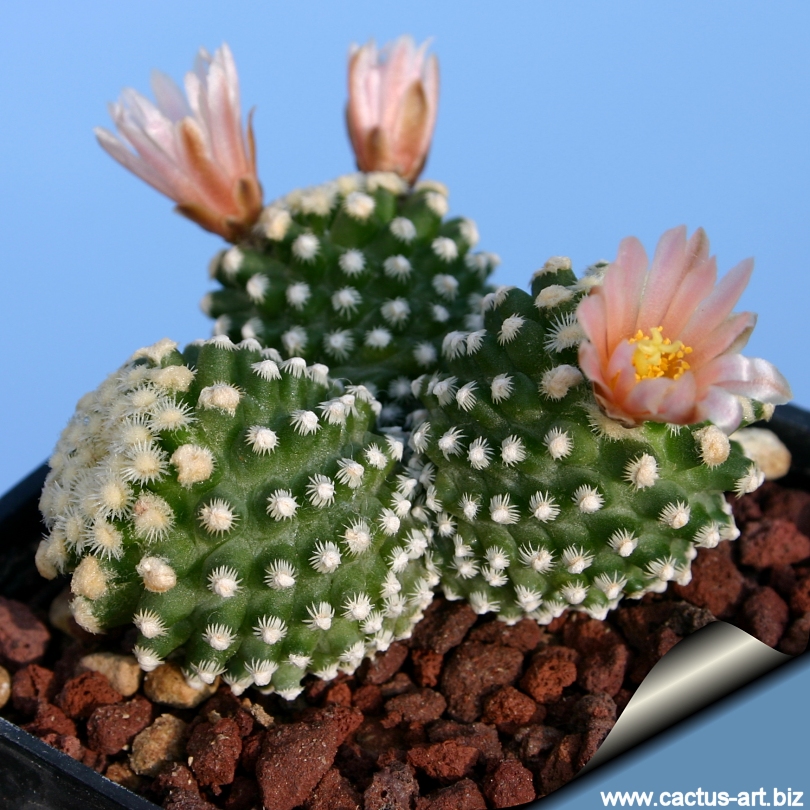
Pediocactus knowltonii (SB304,
San Juan
County, New Mexico, USA)
is the smallest and rarest member of the
genus and found only in New Mexico and Colorado in a very limited area.
|
|
Morphology (Identifying
Characteristics): Very small plant (one of
the world's smallest cactus) usually solitary or a few in a cluster
(Clusters of up to 30 cylindrical stems are reported)
barely protruding above ground level.
Stems: Globular to short cylindrical, 3.5-5,5 cm tall. 2.5-3 cm
in diameter.
Tubercles: Not grooved
Areoles: Circular or slightly elongate, At first woolly but become
smooth with age.
Central spines: This species lacks
central spines.
Radial spines: Smooth, relatively hard, pubescent, mostly 18-26 per
areole, somewhat pectinate, radiating from areole and appressed to the
plant reddish tan, pink, or white, 1-1.5 mm and darkest at tip.
Flowers: Funnel-shaped 1-3.5 cm long by 1-2.5 cm in diameter,
fragrant, borne from previous years areoles near apex of plant, pink,
, tepals white to magenta, usually pink, stigmata yellowish or pale
green, ovary with few tiny papery scales.
Blooming season: Early in
spring (April or May). Flowers are produced when plants
reach 3 or 4 years of age and last only 2 to 3 days and are open for
approximately 3 hours in mid-morning and early afternoon. Flower buds
are set in the fall after a period of summer dormancy and remain
unopened through the winter.
Fruit: Flat, barrel-shaped, fleshy, not juicy, on top and
approximately 4 mm long. Most plants produce 2 or 3 fruits.
Fruits are green-tannish, drying, dehiscent by
circumscissile split at top and one or more vertical splits. Fruits are
produced from late May to early June and dehisce in mid or late June and
on average contain 10 to 12 seeds.
Seeds: 1.5 mm long and 1 to 1.2 mm wide teardrop-shaped with low
nearly flat tubercles, hilum sublateral and with a whitish strophiole.
Similar Species: Could be
confused with some species of Escobaria, but it differs in having
no groove on tubercles, ovary and fruit with scales, fruit dehiscent,
and seeds larger and not pitted. Closely related to P. simpsonii,
but it is separable by recurved appressed radial spines with no central
spines; some juveniles of P. simpsonii lack central spines and
are nearly identical.
|
|
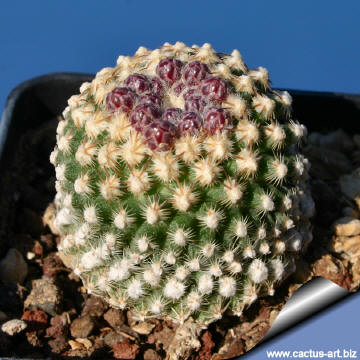 |
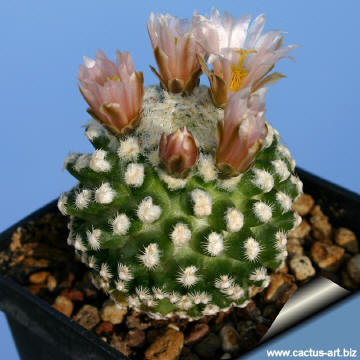 |
|
|
|
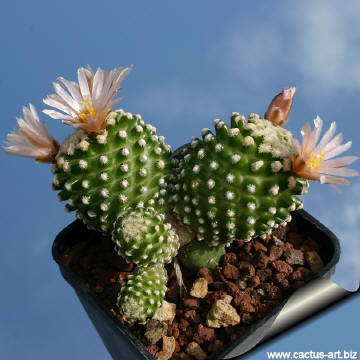 |
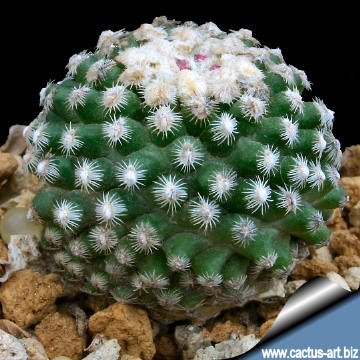 |
|
 |
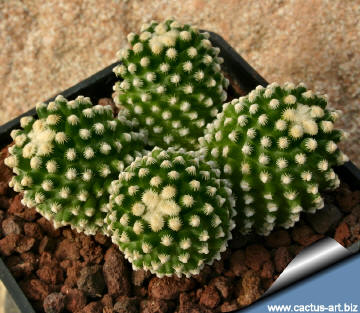
Spines are all radial, mostly 18-26 per areole, somewhat pectinate 1-1.5
mm long. |
|
Advertising


|
|
|
|
|
|
Family:
Cactaceae (Cactus
Family)
Scientific Name:
Pediocactus knowltonii
L. D. Benson, Cact. Succ. J. (Los
Angeles). 32: 193. 1960.
Synonyms:
-
Pediocactus
bradyi var. knowltonii (L. D. Benson) Backeberg; 1976
-
Pediocactus
simpsonii var. knowltonii (L. D. Benson) Halda
-
Toumeya knowltonii anon., nom. Nud.
Common English Names include: Knowlton cactus,
Knowlton's miniature cactus, Knowlton's minute cactus
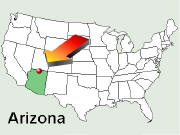 Distribution:
Pediocactus knowltonii is a rare, endemic cactus that is
presently known to occur on a single hill in a very limited area in
the northwestern part of San Juan County
and Rio Arriba counties and Colorado's Archuleta
County, New Mexico on the Colorado border. ± 2000-2300 m.
) There may be only 2 Knowlton's miniature cactus
populations, the largest of which occurs in a 6 ha area south of La
Boca, Colorado and the other occurs in nearby Reese Canyon.
Type locality: 1 mile south of La Boca, Colorado. Distribution:
Pediocactus knowltonii is a rare, endemic cactus that is
presently known to occur on a single hill in a very limited area in
the northwestern part of San Juan County
and Rio Arriba counties and Colorado's Archuleta
County, New Mexico on the Colorado border. ± 2000-2300 m.
) There may be only 2 Knowlton's miniature cactus
populations, the largest of which occurs in a 6 ha area south of La
Boca, Colorado and the other occurs in nearby Reese Canyon.
Type locality: 1 mile south of La Boca, Colorado.
Habitat: Gravel pavements and hill sides on red-brown clay soils in
pinyon-juniper (Pinus edulis -Juniperus scopulorum) woodlands and in
mixed sagebrush (Artemisia spp.) shrublands often in sites where other
vegetation is often lacking. The climateis characterized by little
precipitation, extreme summer heat, low humidity, and very cold winters.
Annual precipitation is approximately 300 mm, and most comes in the
summer and winter months.
Ecology: It has a unique growth pattern that facilitates avoidance
of desert droughts and high temperatures. Generally there are 2 growth
periods in a year. In the early spring (April-May), plants grow, bloom,
and set seed. From June to September, aboveground growth stops, and
plants shrink into the ground. Summer dormancy is considered "very
definite". Cultivated plants receiving supplemental water also
experience summer dormancy. Root growth continues when aboveground plant
parts recede into the ground. After late summer rains, it cactus grows
again. "Offsets", or new stems, are often produced at this time. Often
flower buds are produced in the fall; buds remain unopened through the
winter. Seed dispersal: The limited distribution of and the dry fruits
produced by Knowlton's miniature cactus suggest that wildlife species
are unlikely dispersal agents. Dispersal is probably a result of water
and wind movement that results in scattered high density colonies
Conservation status: Listed in
CITES appendix I
Extensive plant collection by "cactus poachers" reduced populations to
1% of their original levels in nearly 20 years following their
discovery. The small size of Knowlton's miniature cactus made it a
prized botanical collection and rendered it easily accumulated and
concealed. Today's threats to Knowlton's miniature cactus include
habitat destruction related to grazing and oil and gas development
Etymology:
The
genus name "Pediocactus"
derives from the Greek words “Pedion” meaning “plain/level”
referring to the general habitat of the plant on the Great Plains, and
the word “cactus” ( an
old genus name) (The genus name implies: “cactus
of the plains”).
|
|
|
|
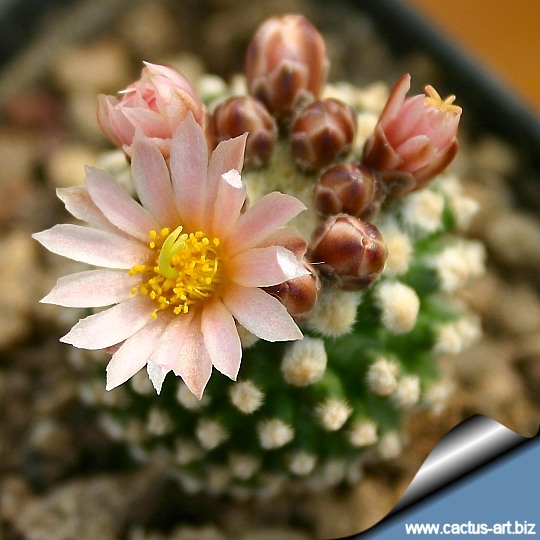

Cultivation:
They are relatively difficult to grow from their own roots, and are
cultivated only by expert cactus enthusiasts. Nevertheless, plants on
their own roots are very hardy.
They don’t tolerate living in humid and heated green houses. Place them
in a ventilated position; they like "wind". Avoid direct sunlight
exposure in summer. Water moderately, only from early March to May. The
rest of the year keep them in dormancy.
They are exceptionally slow growers. For this reason they are frequently
grafted on strong hardy cactus stocks like Opuntia and Echinocereus.
The flowers buds stay dormant on the plant apex all winter, they will
then open in spring when the temperatures rise. To avoid any damage to
the buds, the grafted plants that stay in heated greenhouses should not
be let to completely dry out. Some light watering in winter is useful
for keeping the flowers hydrated and healthy.
Propagation: Seeds:
Temperature for optimum
germination: night minimum approx 17 day maximum to near 40
C at any time of year with proper temperatures and
daylength (ca.13-14 hours); it is possible to extend
day-length with
artificial lights. Anyway the seeds
germinate slowly with difficulty and a low rate of
success (But germiation is
comparatively easy if compared with other Pediocactus
and Sclerocactus species and often new seedling
cluster spontaneously around the plant every year),
scarification and
stratification help, alternate
freeze
and
thaw both wet and dry, but don’t keep wet, alternate wet and
dry with changing temperature.
Germination can take several
years so keep pot and try again next year. Seedlings do not do
well either, and some die each year, for this reason
plants are commonly
grafted on hardy stocks like
Opuntia compressa in this case
they are easy to grow and no special skill is required.
|
|